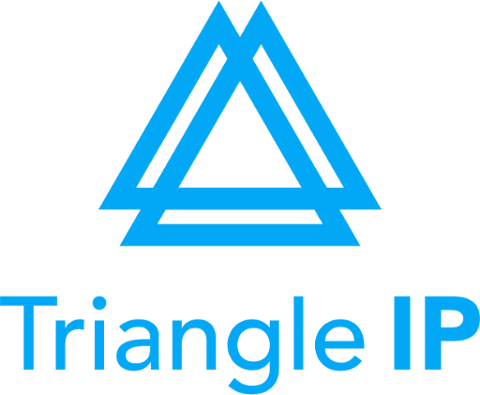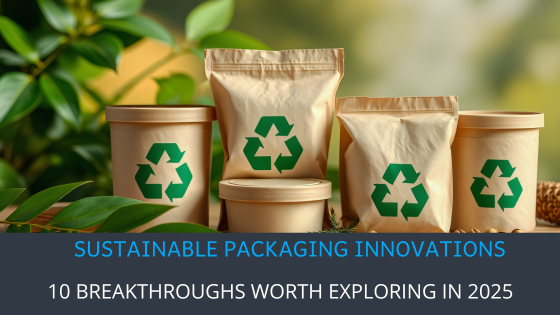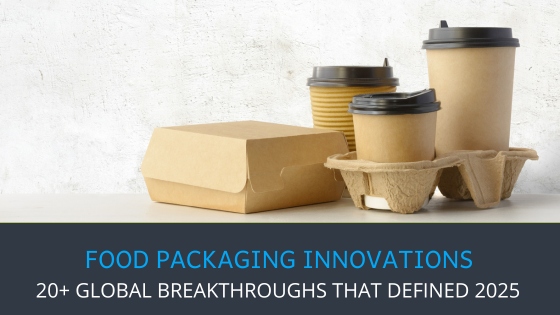Since November 2022, ChatGPT has taken the world by storm. The platform has gained one million users in just five days of its launch. Fast forward to two months, ChatGPT’s monthly active user count crossed the 100 million mark.
Professionals from all over the world are using it for various things, from helping with coding to creating content and even writing emails. What’s really cool is that ChatGPT has potential use cases for innovators, too.
So, in this article, we’ll unveil 20 practical ways to leverage ChatGPT’s capabilities for your innovation projects, each accompanied by a sample prompt.
Let’s dive in!
Fostering Idea Generation & Brainstorming
Groundbreaking ideas often come from a mix of creative thinking and structured ideation. Integrating methods to develop a comprehensive innovation strategy can significantly enhance this process, ensuring a mix of creativity and structured planning. In the early stages, innovators look for new viewpoints, informed insights, and feedback on their ideas. ChatGPT helps by offering vast information, suggesting fresh ideas, and giving instant feedback to enhance them.
Here are some use cases of using ChatGPT for idea generation and brainstorming:
1. Idea Validation
Oftentimes, innovators have a spark of an idea but need to refine it. They can use ChatGPT to gauge an idea’s potential and gather market insights swiftly. By interacting with the AI, they can get immediate feedback, understand market trends, and assess risks, offering a quick and cost-effective way to test the viability of their concepts before diving deep.
Prompt: “Considering advancements in 3D printing, is there a market for customized home decor produced this way? How might consumer preferences align or clash with this idea?”
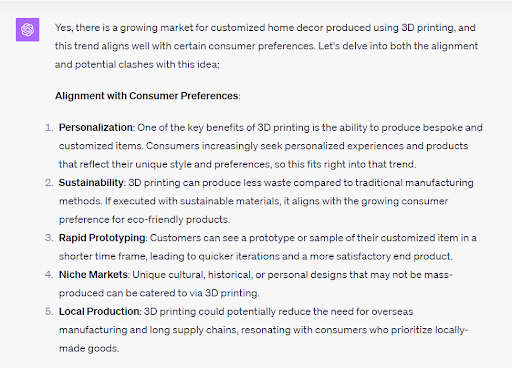
Source – ChatGPT

Source – ChatGPT
2. Brainstorming Companion
ChatGPT can act as a brainstorming partner, helping innovators expand on initial ideas, suggest alternative solutions, or introduce related concepts that might have yet to be considered. Engaging with this AI platform allows them to challenge, refine, and expand their concepts, ensuring a richer and more comprehensive ideation process.
Prompt: “Given the rapid growth of the smart home industry, what are potential household tasks or activities that haven’t been widely automated or enhanced with AI yet?”
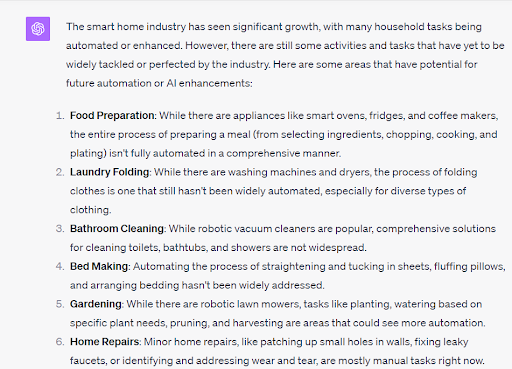
Source – ChatGPT
3. Scenario Simulations
It’s essential to anticipate potential outcomes and user reactions before rolling out any innovations into real products. By presenting hypothetical scenarios to the AI, innovators can anticipate challenges, gauge reactions, and strategize solutions, providing a robust foundation for their innovative pursuits.
Prompt: “We are looking to create a subscription-based online learning platform. Simulate a scenario where a major competitor slashes their prices by half. How might this impact our subscriber growth, and what counter-strategies could we consider?”
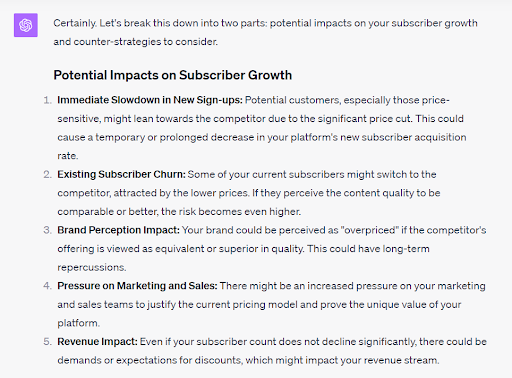
Source – ChatGPT
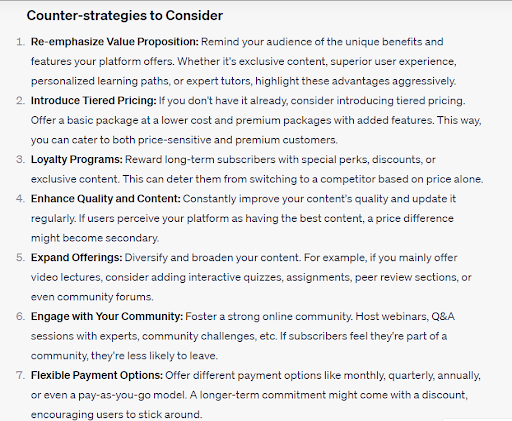
Source – ChatGPT
4. Naming and Branding
A brand’s name and image play a crucial role in its market perception and success. ChatGPT can help brainstorm creative, relevant, and impactful names and branding strategies for products, services, or companies by feeding AI with brand values, target audience, and product specifics.
Prompt: “I am starting a vegan fast food chain. Brainstorm a brand name that captures the essence of fast, delicious, and 100% vegan offerings.”
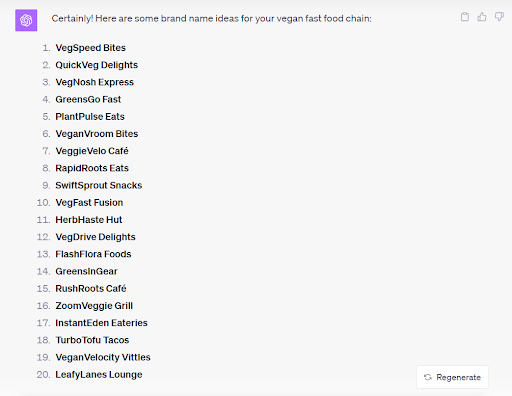
Source – ChatGPT
Content Creation & Prototyping
After the idea validation and brainstorming phase, innovators seek to translate their abstract ideas into tangible forms or compelling narratives. Encouraging innovative thinking throughout the organization can further refine these initial representations. ChatGPT aids this process by generating creative content drafts, offering design feedback, and simulating user interactions with prototypes. With this AI-driven approach, innovators can ensure that their initial representations align closely with their vision while resonating with the target audience.
Some use cases of using ChatGPT for content creation and prototyping are:
5. Content & Pitch Drafting
Creating compelling content, whether a business proposal, marketing pitch, or product description, is an art. ChatGPT can assist in drafting, refining, and optimizing this content to resonate with specific audiences and generate better engagement.
Prompt: “We are starting an online mental health counseling service. Write a heartfelt mission statement for our platform that underscores the importance of accessible mental health resources and our dedication to connecting individuals with qualified professionals.’’
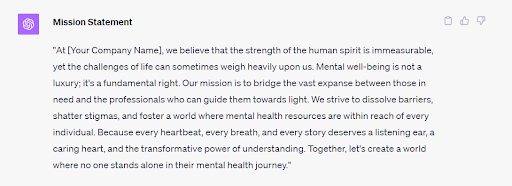
Source – ChatGPT
6. Creating Mockups or Narratives for New Products/Services
Before delving into full-fledged development or launch, creating mockups or compelling narratives can help visualize the end product and its value proposition. ChatGPT can guide innovators in developing these preliminary representations or stories, ensuring that the preliminary versions of their innovations are both engaging and illustrative.
Prompt: “Design a mockup of a wearable device focused on health monitoring and fall detection for seniors.’’

Source – ChatGPT
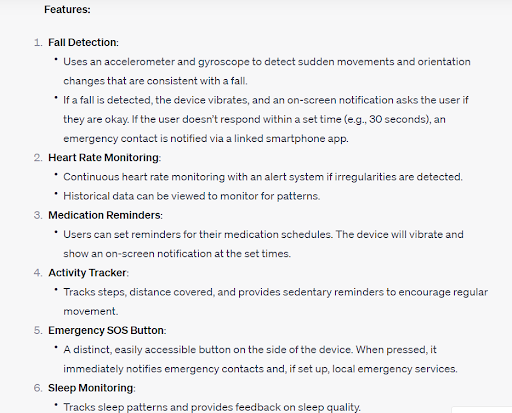
Source – ChatGPT
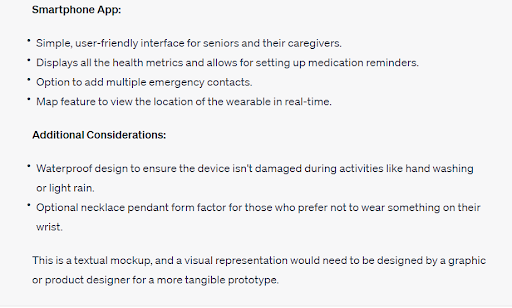
Source – ChatGPT
Now, weave a narrative that emphasizes the peace of mind it offers to both wearers and their families.
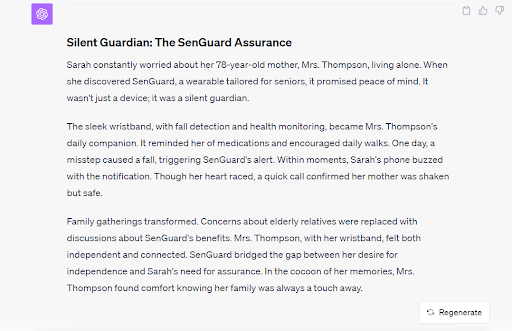
Source – ChatGPT
7. Business Plans
A comprehensive and compelling business plan is essential for startups and businesses seeking funding or defining their strategic direction. ChatGPT aids in structuring a comprehensive plan, ensuring key components like market analysis, strategies, and projections are well-articulated, setting a solid foundation for their innovative ventures.
Prompt: ‘’Outline a business plan for a mobile health clinic aiming to serve remote communities.
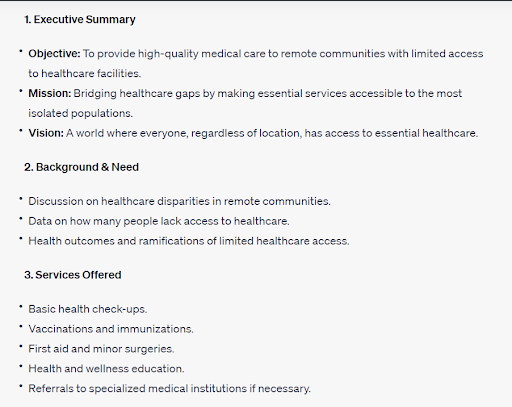
Source – ChatGPT
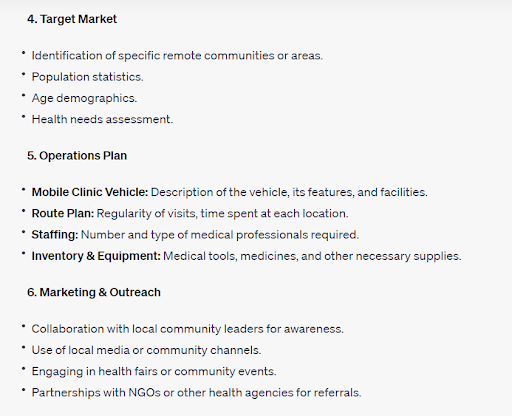
Source – ChatGPT
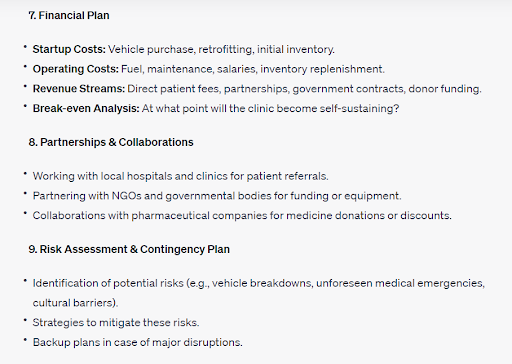
Source – ChatGPT
8. Revenue Models
Determining the most suitable revenue model is crucial for the financial success of any innovation. ChatGPT can provide insights into various revenue models, their pros and cons, and suggest the best fit based on the product or service specifics.
Prompt: ‘’Hi, what are the most common membership tier structures for co-working spaces, and how do they vary in terms of pricing and access?”
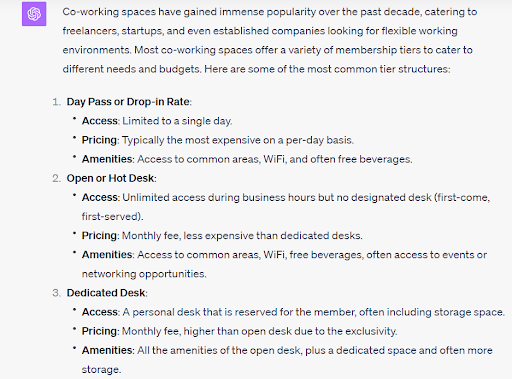
Source – ChatGPT
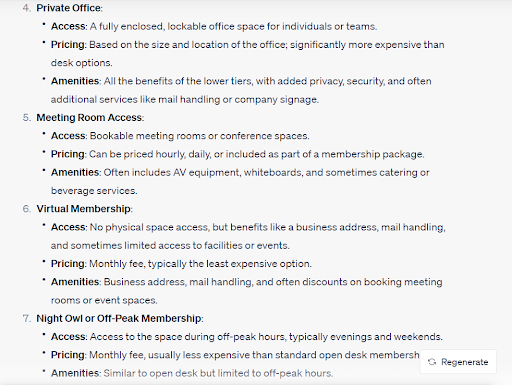
Source – ChatGPT
Market Analysis & Positioning
Innovators always aim to understand where their innovations fit within the broader landscape and how they can carve a distinctive niche. ChatGPT becomes a key ally in this phase, offering insights on current market dynamics, competitor benchmarks, and audience sentiments. With such data-driven guidance, innovators can strategically position their offerings to maximize reach and resonance.
Here are some use cases of using ChatGPT for market analysis and positioning:
9. Market Gap Identification
Identifying unserved needs or gaps in the market is essential to innovate effectively. Through the AI’s extensive knowledge base and real-time data interpretation, innovators can spot potential opportunities and areas ready for innovation, ensuring their solutions address genuine market demands.
Prompt: “With the growing trend of remote work, what tools, functionalities, or solutions seem to be lacking for companies and remote employees to optimize their productivity and well-being?”
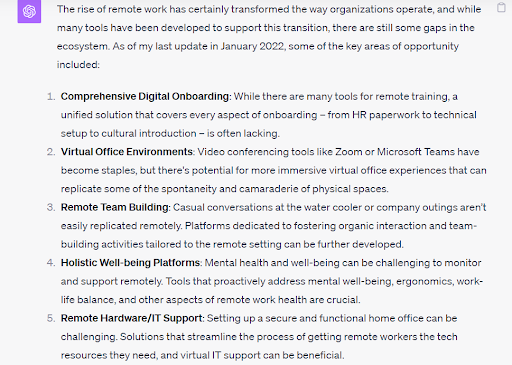
Source – ChatGPT
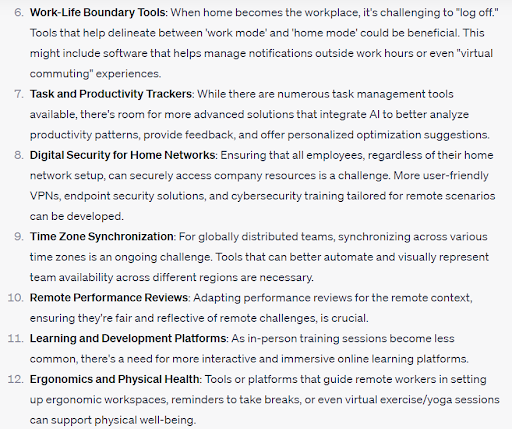
Source – ChatGPT
10. Trend Forecasting
While it’s essential to address current needs, forward-thinking innovations anticipate future trends. ChatGPT can analyze past and present patterns to forecast future shifts, helping innovators stay ahead of the curve.
Prompt: “Given the current trajectory of VR tech, what genres or types of virtual experiences might become mainstream in the entertainment industry by 2025?”
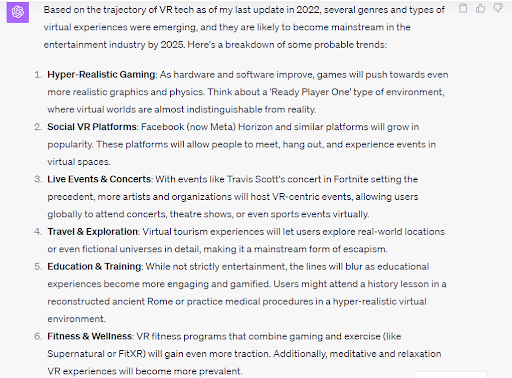
Source – ChatGPT
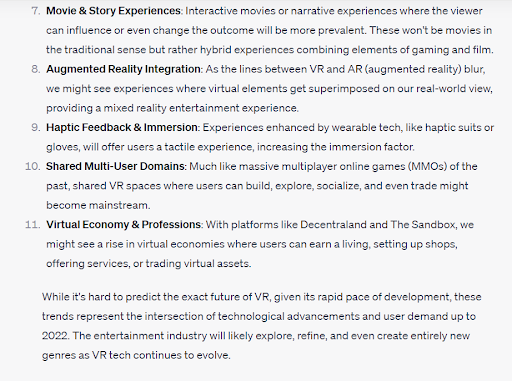
Source – ChatGPT
11. Competitive Analysis
Understanding your competition is vital to understanding the strengths and weaknesses of rivals in your domain. By querying the ChatGPT on competitor strategies, product features, and market presence, innovators gain a holistic view, enabling them to differentiate their innovations and carve a unique market position.
Prompt: “Considering the digital coding education landscape, which platforms are most prominent? What features or strategies do they employ that sets them apart?”
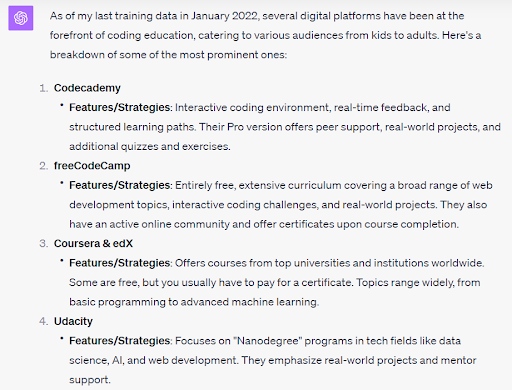
Source – ChatGPT
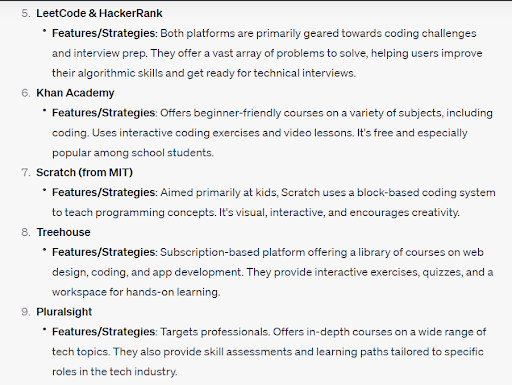
Source – ChatGPT
12. Risk Assessment
Every innovation comes with potential risks. Identifying and understanding these risks early can be crucial for mitigation and planning. ChatGPT can assist in highlighting potential risks associated with a product, service, or business model and suggest strategies to address them.
Prompt: “Given the intricacies of autonomous vehicles, outline the potential technical and regulatory risks associated with launching a self-driving car rental business.”
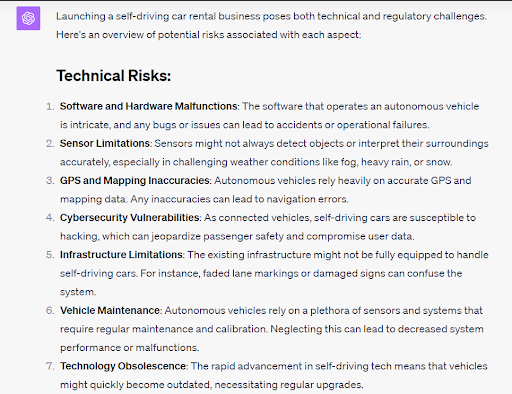
Source – ChatGPT
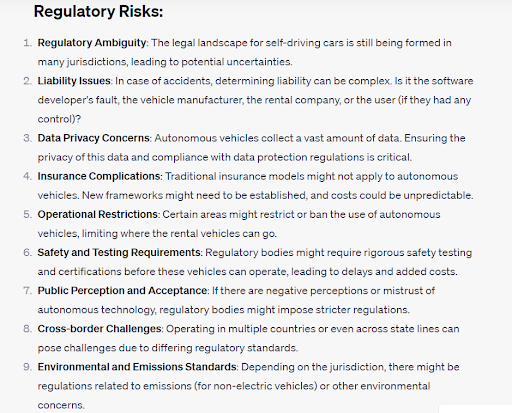
Source –ChatGPT
13. Creating User Personas
For effective targeting, understanding your user is crucial. ChatGPT can assist in crafting detailed and varied user personas based on product specifications. By synthesizing demographic, psychographic, and behavioral data, ChatGPT aids in creating rich profiles that guide product development and marketing strategies, ensuring innovations resonate deeply with target users.
Prompt: “Considering the sustainable beauty market, can you help define a user persona for someone highly invested in eco-friendly cosmetic products?”
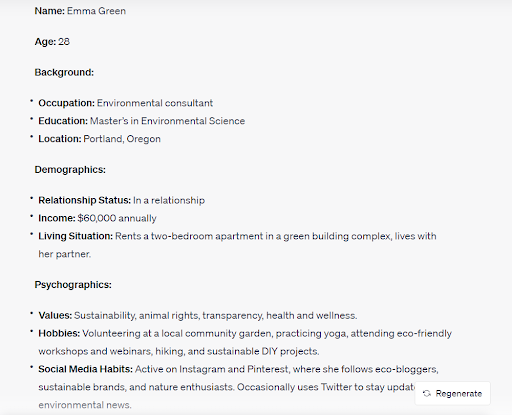
Source – ChatGPT
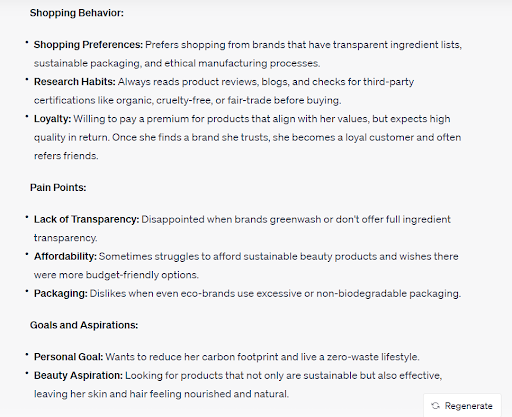
Source – ChatGPT
Networking & Collaboration
Innovators often seek to connect with like-minded individuals, gather insights from peers, or find potential collaborators to aid their innovation. ChatGPT serves as a bridge, suggesting networking opportunities, simulating collaboration scenarios, and providing insights on industry thought leaders. Through these AI-facilitated interactions, innovators can expand their horizons, drawing inspiration and forging valuable partnerships.
Here are some use cases of using ChatGPT for networking and collaboration:
14. Outreach Emails/Messages
Building relationships and collaborations can significantly propel an innovation forward. ChatGPT can craft impactful outreach emails and messages, aiming to engage potential collaborators or stakeholders. By inputting their objectives and target audience into the AI, innovators receive tailored communication drafts that enhance response rates, ensuring their networking efforts are both strategic and effective.
Prompt: “Given our focus on organic food logistics, can you help craft a compelling outreach message to invite key influencers for collaboration?”
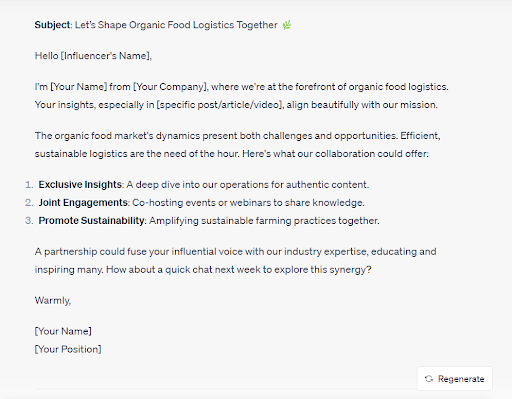
Source –ChatGPT
15. Q and A Scenarios for Meetings and Pitches
Being prepared for questions during meetings or pitches is vital. ChatGPT can simulate potential questions stakeholders or investors might ask, allowing innovators to prepare and refine their answers. By giving the AI potential questions or concerns, innovators can also receive well-articulated responses, ensuring they can handle inquiries and objections confidently and clearly during live sessions.
Prompt: “Hi, we’re pitching our sustainable fashion brand to investors. What are the top questions they might ask regarding our sourcing, manufacturing process, and impact on the environment?
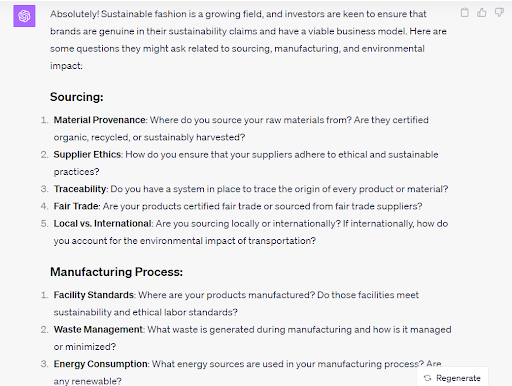
Source – ChatGPT
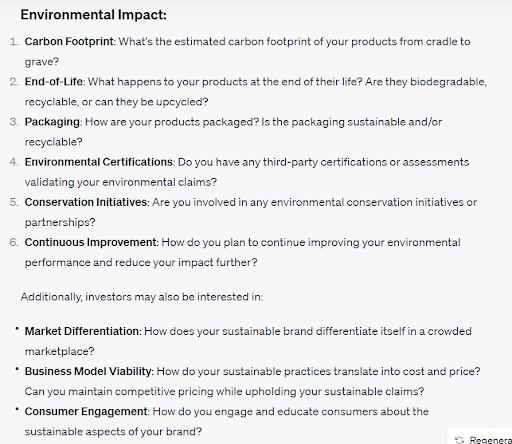
Source –ChatGPT
16. Interview Scripts
Conducting interviews requires a structured and compelling script, whether for user research, hiring, or media interactions. ChatGPT can assist in framing tailored interview questions, ensuring they are relevant, unbiased, and elicit the desired information or response.
Prompt: “Hi, we are creating a platform for remote team collaboration. We need interview questions to ask remote employees, team leads, managers, and executives that can help us understand the difficulties remote teams face, tools they currently use, and features they wish existed to enhance collaboration.”
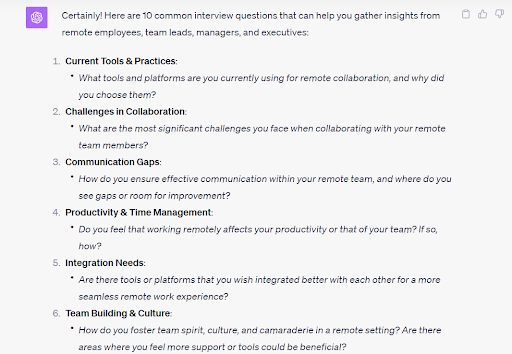
Source – ChatGPT
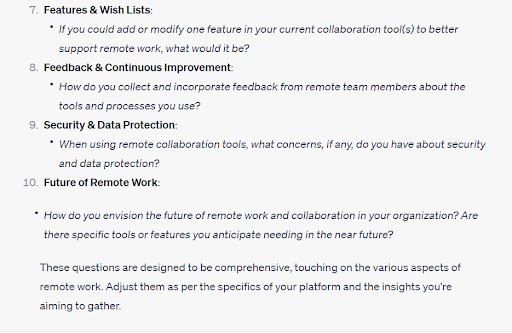
Source – ChatGPT
Technical and Product Development
During this phase of innovation, innovators delve deep into the intricacies of turning concepts into substantial offerings. ChatGPT becomes an invaluable assistant here, offering guidance on technical specifications, product design, and optimization strategies. By tapping into the AI’s vast technical repository, innovators ensure their creations are innovative, feasible, and market-ready.
Here are some use cases of using ChatGPT for technical and product development:
17. Technical Code Assistance
For tech-driven innovations, coding challenges are frequent with innovators. ChatGPT can provide quick solutions to coding challenges and optimizations, recommend best practices, and even assist with debugging. This accelerates the development process and ensures their technical implementations are robust and efficient.
Prompt: “I’m looking to integrate a recommendation system in my fitness app that suggests workouts based on user preferences. Could you show me a simple Python implementation using sci-kit-learn?”
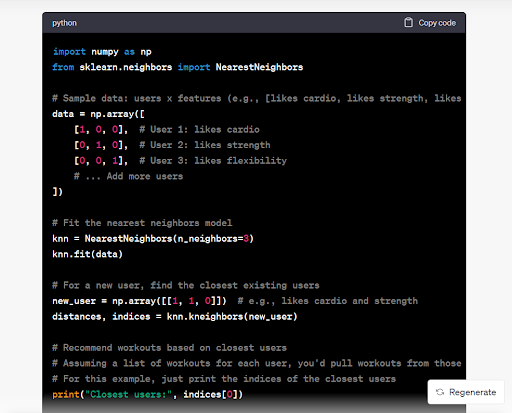
Source – ChatGPT
18. Prototype Feedback Collection
Feedback during the prototype phase can save enormous resources and time. Innovators use ChatGPT to gather feedback on their prototypes, simulating user interactions and extracting insights. By presenting their prototype details and desired user outcomes to the AI, they receive objective evaluations and potential improvement areas, ensuring that their final products are fine-tuned to meet user expectations and market needs.
Prompt: “We are developing a Personal Finance Chatbot. Given the chatbot’s ability to provide budgeting tips, expense tracking, and financial advice, what potential user pain points might arise, and how could they be addressed in our prototype?”
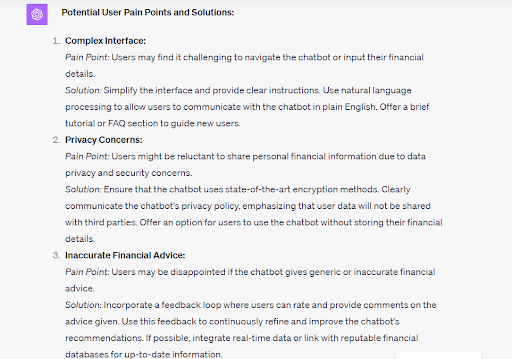
Source – ChatGPT
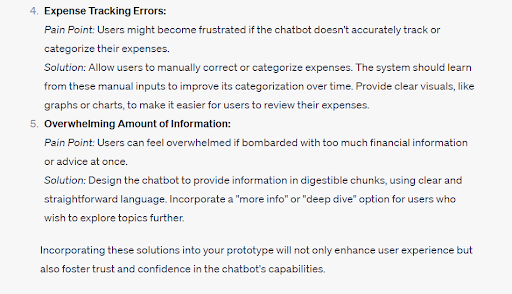
Source – ChatGPT
19. User-Centered Feedback
Getting feedback from the lens of potential users is invaluable. ChatGPT can provide an outsider’s perspective on usability, design considerations, and potential improvements of an innovation. This feedback loop ensures that products or solutions align closely with user preferences and real-world scenarios.
Prompt: “Hi, if you were a user relying on a smartwatch primarily for health tracking, what concerns or questions might you have about a new feature that predicts fatigue levels?”
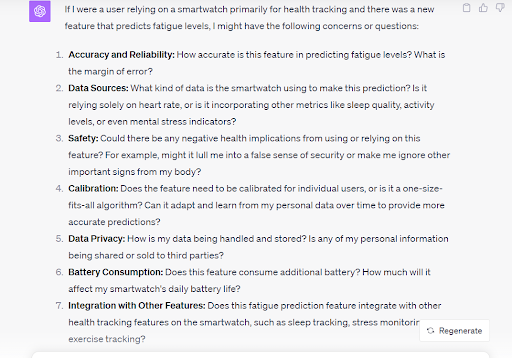
Source – ChatGPT
Operational Efficiency & Process Optimization
Innovators strive to streamline operations and maximize the utility of resources when developing a new product/service. ChatGPT emerges as a pivotal tool in this endeavor, offering insights on workflow enhancements, task automation, and best practices.
Here’s a use case of ChatGPT for operational efficiency and process optimization
20. Workflow Analysis
Innovators leverage ChatGPT for workflow analysis to pinpoint inefficiencies and areas of improvement in their processes. The AI can provide insights into potential redundancies, optimization opportunities, and best practice recommendations, ensuring a streamlined and more productive operational flow.
Prompt: “We have an e-commerce business for handmade crafts. Detail a workflow streamlining our process for receiving custom orders on our platform.
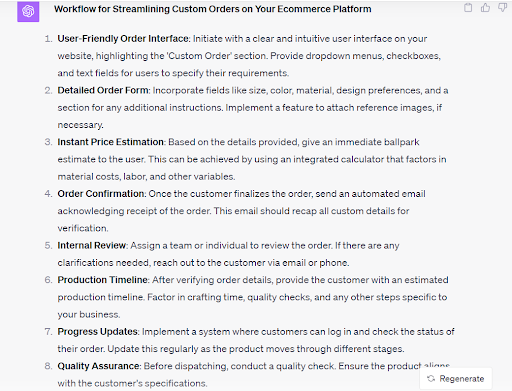
Source – ChatGPT
ChatGPT and Innovators: A Partnership Redefining the Innovation Landscape!
Innovation is the driving force behind progress, and ChatGPT has proven itself as a vital tool for creative thinkers. Whether you’re brainstorming new ideas or analyzing markets, ChatGPT is versatile and ready to assist.
However, safeguarding these innovations is just as crucial. This is where the TIP Tool™ steps in, offering a robust solution for streamlined idea and patent management. With features like a centralized repository, patentability prediction, journey tracking, cost estimation, and patent portfolio overview, it empowers your innovation journey from start to finish.
Don’t just innovate; protect your innovations with the TIP Tool™. Learn more and start today.
